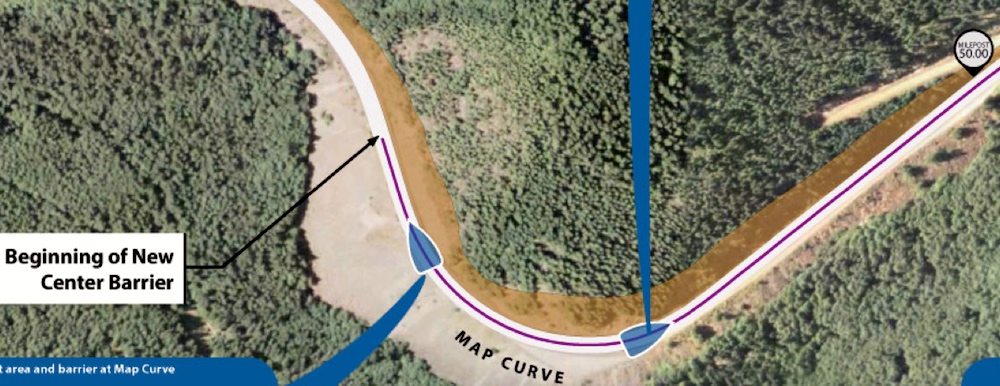If you are waiting for design improvements to solve the traffic problems on Mount Hood, don’t hold your breath.
The Oregon Department of Transportation has no plans to add westbound lanes to key choke points on a section of roadway where it routinely takes two, three, sometimes even four hours to drive two miles. ODOT spokeswoman Kimberly Dinwiddie explained in an interview this week that traffic engineers have studied and rejected plans to add westbound lanes to Hwy. 26 near Government Camp, and are instead focusing on public education, the ongoing $25 million Mt. Hood Safety Project, and a new Real-Time Project that will install new electronic signs to inform drivers of road conditions and travel times.
A Jan. 2 Shred Hood article about traffic jams on the mountain drew more than 150 comments from the skiing and snowboarding community on Facebook and the web, with many readers calling for new lanes on 26, a stronger police presence, fewer 18-wheelers, more mass transit, slopeside lodging, stop lights and snow driving enforcement and education.
One particularly popular suggestion involves using the center lane of 26 for westbound traffic in the evenings and eastbound traffic in the mornings. This could be accomplished without significant road work because there is already plenty of space in the existing road.
The two-mile stretch of 26 West from Hwy. 35 to Skibowl West often backs up for miles on weekend afternoons, with travelers returning from Central Oregon, Mt. Hood Meadows, Trillium Lake, Timberline, Government Camp and Skibowl. Westbound travelers merge from two lanes to one lane just before Timberline, creating a massive cluster on an often icy hill. The central lane, meanwhile, is wide open and largely empty, reserved for eastbound traffic with few cars heading east. It would seem to make sense to use that available space to move traffic westbound at peak times.
Dinwiddie told Shred Hood that ODOT traffic engineers have studied the idea of adding westbound lanes in the past and rejected it for three reasons:
- Price and Design: “We would have to put up a sign structure that would span across the entire highway, and we would have to put electronic signs of both sides of that structure to tell people about the lanes. We don’t think that would be consistent with the Mt. Hood Forest Plan. It could really be an eyesore for the community. And structures like that can range in the one-million-dollar-plus range.”
- Safety: “If we took away that center turn lane, we think we would see an increase of crashes. Because you would have eastbound drivers stopped in the center lane, looking to take a left into Government Camp, and we would see more west-bounders plowing into those people and then secondary crashes occurring.”
- Conflicts with Ongoing Work: Part of the Mt. Hood Safety Project involves building a 2-mile concrete barrier in the center of Hwy. 26 downhill from Skibowl. “If we had two lanes of westbound traffic on 26 we would get back-ups into Government Camp because of the merge point (for the new barrier).”
The safety concerns Dinwiddie outlines strike me as legitimate, but the price and design qualms seem thin to say the least. ODOT is already planning to spend millions to install three new electronic signs; why would this particular sign be more of an expensive “eye-sore” than the others?
Instead of adding lanes, ODOT is focusing on wrapping up its $25 million Hwy. 26 construction project in 2016, adding real-time electronic signs at Meadows, Frog Lake and Timberline in 2017, encouraging transit and ride-sharing, and educating drivers about route options and safe winter driving tips.
Dinwiddie touched on some of the details of these initiatives in our conversation this week, which I will publish below, edited for brevity and clarity. Feel free to add your responses and suggestions into the comments section below:
It’s going to be busy this weekend for the MLK Holiday. Does ODOT have any plans to intervene and improve traffic flow and safety on the mountain?
We always have people working on holidays, and we will do the best we can to keep the roads safe and passable for travelers. However, we ask that travelers be prepared for any winter weather driving conditions that they may encounter.
Are you guys in touch with Oregon State Police about the traffic situation on 26 on Mount Hood? Do you communicate before big weekends?
Oregon State Police does have somebody stationed up there and they were out there during Winter Break enforcing chain rules and other traffic violations. Our ODOT managers do coordinate with the OSP staff on site.
Are there any projects in the works to improve traffic flow on 26 West after big ski days?
Our primary purpose is to make sure that people get to where they are going safely. Our projects are really targeted toward safety, but we’re also launching another project that will give travelers real-time information to make informed decisions on which route to use. That’s the ODOT Real-Time Project, which places electronic signs at key locations throughout the mountain. Those signs will give people immediate road conditions that will change based on sensors, and they will let people know when the road is icy. Another feature that could really help travelers is travel time signs that will tell you how long it will take you to get to your destination following different routes. That gives travelers the choice on whether to go via 26 or 35. This project is under design and we should see construction by 2017.
Where exactly will the electronic signs be?
We are currently looking to place one on Timberline Road, one on Hwy. 26 West near the Frog Lake Area (east of the pass, for travelers from Central Oregon), and one at Mt. Hood Meadows.
Those signs should help. Now what about the idea that two lanes heading westbound on 26 would really move things along during peak hours: Has that been studied? Is it a possibility? Because when you are stuck in traffic heading west, there sure is a lot of real estate to your left. There is a lot of road that is not being used over there.
We have considered it, and I asked our traffic engineers about that. It wouldn’t work for a number of reasons. One, if we did temporary, two-way lanes on 26, especially through Government Camp, we would have to put up a sign structure that would span across the entire highway, and we would have to put electronic signs of both sides of that structure to tell people about the lanes. We don’t think that would be consistent with the Mt. Hood Forest Plan. It could really be an eyesore for the community. Structures like that can range in the one-million-dollar-plus range. That’s one constraint. The second constraint is safety. If we took away that center turn lane, we think we would see an increase of crashes. Because you would have eastbound drivers stopped in the center lane, looking to take a left into Government Camp, and we would see more east-bounders plowing into those people and then secondary crashes occurring. And then the third reason is the nearly 2-mile concrete barrier planed for the U.S. 26 Safety Project, east of the Mirror Lake Curves. If we had two lanes of westbound traffic on 26 we would get back-ups into Government Camp because of the merge point.
So two lanes westbound on 26 has been looked at and rejected for specific reasons.
Yes. There was a transportation survey done two years ago, and it included the Forest Service, ODOT, Clackamas County and representatives from the ski industry such as Timberline and Skibowl, and we looked at using that center lane for Westbound traffic. So it has been discussed broadly among that group.
How about mass transit? Any progress there?
More people on buses and out of cars is a great idea. The Mt. Hood Express is a transit option for the mountain. It’s operated by Clackamas County and operates seven days a week. We’ve increased the funding for the Mt. Hood Express over the winter, to help with holiday weekends and busy ski days. And another thing that is more carpool related is, Oregon has a ride-sharing website called drivelessconnect.com, and it connects people who are heading to similar destinations at similar times. So that is another unique way to meet new people and get fewer cars on the road.
Does ODOT count cars on the mountain?
I’m working on pulling those numbers for a comparison between 2013 and 2015, for the month of December, compared to summer months. Those numbers should be available by January 25th. Regrettably the 2014 traffic counter was wiped out in a car crash, so we don’t have any numbers for 2014.
Somebody smashed into the traffic-counter on the side of the road? On an icy day?
Yeah, that’s when we see most of the crashes. You know, over the winter months ODOT has been trying to reach out to people through social media and traditional media to get people to consider the travel times of where they are going. Most of the times the commute is heavy westbound in the evening and eastbound in the morning, so if some people could adjust their travel times, that could really help. We’re also trying to encourage people who are just passing through, heading from Central Oregon to the Valley, to use alternate routes other than Highway 26 over Mount Hood. There’s plenty of other routes.
But as a skier, consider transit, consider ride-share, consider adjusting your timing to arrive earlier and stay later to avoid those peak flows. And know other routes. Sometimes Highway 35 is faster to get back to town. And be prepared. As your readers know, there are a lot of people who are unprepared up there, who go up there without the proper vehicle or tires or chains, and they refuse to use their chains. That creates a safety problem for everyone, and it leads to congestion as well. Also it comes down to knowledge and skill for driving in the ice and snow. If you don’t know how to drive in these conditions, leave the driving to somebody else.
Well you saw the comments we got about this issue online and on Facebook. People get grumpy when they get stuck in traffic for hours.
I appreciate the angry perspective. It gives us context, and we need that.
Okay, readers, what do you think of ODOT’s plans for Mount Hood? Will they work? And what would you suggest?
Last modified: January 15, 2016


